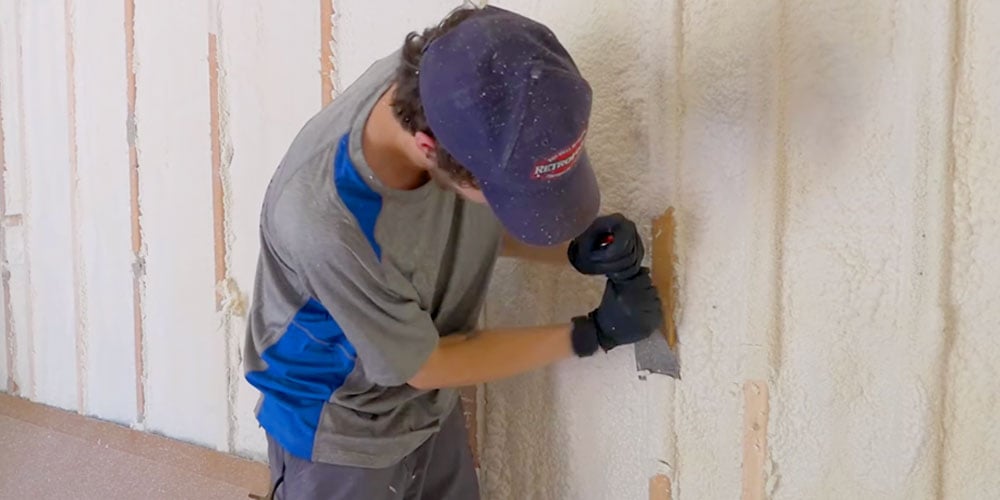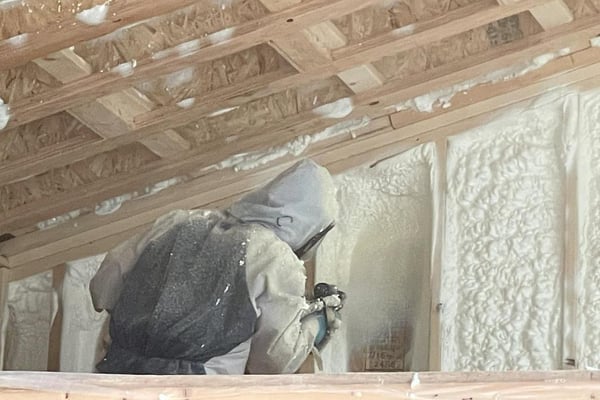Frequently Asked Questions About Spray Foam Installation and Usage
Frequently Asked Questions About Spray Foam Installation and Usage
Blog Article
Spray Foam: The Ultimate Remedy for Air Sealing and Insulation
Spray foam insulation has actually emerged as a leading solution for effective air sealing and thermal insulation, providing a special mix of properties that set it apart from traditional methods. Its ability to expand and fill gaps makes it particularly effective in preventing air leak, which can dramatically influence power effectiveness. Comprehending the full scope of its advantages, setup processes, and contrasts with various other insulation types is essential for making informed choices. As we check out these aspects, the effects for both brand-new constructions and retrofits become significantly considerable. What elements should affect your option?
What Is Spray Foam?
Spray foam is a versatile insulation product that combines the principles of air securing and thermal resistance to enhance energy performance in buildings. Made up largely of polyurethane or other similar substances, spray foam is applied as a liquid that increases upon contact with surfaces, producing a strong, continuous layer of insulation. This special home permits it to fill gaps, fractures, and gaps that traditional insulation materials might forget, providing a remarkable air seal.
There are 2 major types of spray foam: open-cell and closed-cell. Open-cell spray foam is lighter and much more versatile, supplying excellent sound absorption and a lower R-value per inch - Spray Foam. In comparison, closed-cell spray foam is denser, giving a greater R-value, dampness resistance, and added structural integrity to developing elements
The application process commonly entails customized equipment, ensuring a seamless application that abides by various substrates, consisting of timber, steel, and concrete. This flexibility makes spray foam ideal for both brand-new building and constructions and retrofitting existing frameworks. Its capability to produce a closed barrier considerably contributes to reducing power intake and boosting interior air high quality, thus making it a preferred choice amongst builders and home owners alike.
Advantages of Spray Foam Insulation
One of the most substantial advantages of spray foam insulation is its extraordinary capability to create a continual air obstacle, which successfully lessens energy loss. Unlike conventional insulation products, spray foam increases to fill up gaps and splits, guaranteeing that air leak is substantially minimized. This characteristic not only improves energy performance however likewise causes lower energy expenses over time.
In addition, spray foam insulation gives premium thermal resistance, adding to a more steady interior atmosphere. Its high R-value per inch permits effective insulation in constrained spaces, making it excellent for attics, wall surfaces, and crawl rooms. The moisture-resistant residential properties of spray foam aid prevent mold and mold development, advertising healthier living conditions.
One more essential advantage of spray foam insulation is its sound-dampening qualities (Spray Foam). It effectively decreases noise transmission in between spaces, developing a quieter and extra comfy home environment. The sturdiness of spray foam additionally attracts attention, as it does not droop or settle in time, preserving its performance throughout its life expectancy
Exactly How Spray Foam Works
Comprehending exactly how spray foam insulation works is vital for appreciating its efficiency in air sealing and thermal resistance. Spray foam insulation contains two primary parts: isocyanate and polyol material. When these parts are blended, they go through a chain reaction that causes the material to increase swiftly, developing a dense foam that fills cracks, voids, and dental caries.
As the foam expands, it follows surface areas, developing an airtight seal that significantly decreases air infiltration. This characteristic makes spray foam insulation highly efficient at avoiding drafts and wetness penetration, which can lead to energy loss and damage in time. Additionally, the closed-cell variation of spray foam offers exceptional thermal resistance due to its inflexible structure, efficiently minimizing warmth transfer.
The distinct homes of spray foam allow it to adjust to irregular surface areas, ensuring detailed coverage and a seamless obstacle. Because of this, spray foam insulation not only boosts energy effectiveness yet also adds to boosted indoor air high quality by lowering the accumulation of pollutants and irritants. Ultimately, comprehending the technicians behind spray foam underscores its function as a premium choice for insulation and air sealing in both property and business applications.
Installation Process Overview

Before setup, the area has to be adequately cleaned and prepped, making certain that surfaces are without wetness, dirt, and particles. This step is Click Here important since pollutants can jeopardize bond and general performance. As soon as the location is prepared, the application includes mixing both components of the spray foam, which increases upon call and loads spaces successfully.
Trained professionals should perform the installment, using specific equipment to make certain consistent protection and optimal thickness. Security safety measures, including putting on protective gear and making certain appropriate ventilation, are important during this procedure. After application, the foam usually cures promptly, developing a solid obstacle that enhances power efficiency.
Contrasting Spray Foam to Standard Insulation
When assessing insulation alternatives, spray foam insulation sticks out in comparison to typical materials such as fiberglass and cellulose. Among the primary benefits of spray foam is its superior air page securing capabilities. Unlike fiberglass and cellulose, which can enable air infiltration, spray foam broadens upon application, filling gaps and voids to create a closed seal. This results in improved power efficiency, as less warmed or cooled air gets away the home, leading to lower energy costs.
Additionally, spray foam supplies a greater R-value per inch than typical insulation types, providing more efficient thermal resistance in a thinner account. This particular is particularly useful precede with minimal dental caries deepness. Spray foam is immune to dampness and mold and mildew development, which can be a significant concern with cellulose and fiberglass, particularly in humid environments.
However, spray foam insulation typically carries a greater ahead of time price than its typical equivalents. House owners need to evaluate this preliminary investment against lasting power cost savings and performance benefits. Inevitably, while both insulation kinds serve their purpose, spray foam becomes an extra innovative option for modern insulation needs, specifically in regards to air sealing and thermal efficiency.

Verdict
In summary, spray foam insulation represents an extremely reliable solution for accomplishing optimum air see here now securing and thermal resistance. Its distinct buildings, including moisture resistance and noise dampening, make it appropriate for numerous applications in both brand-new constructions and retrofitting tasks (Spray Foam). Although the first costs may be higher compared to conventional insulation materials, the long-lasting advantages, such as substantial power financial savings and boosted interior air top quality, justify the investment and underscore its value in modern structure techniques.
Spray foam insulation has actually emerged as a leading service for effective air securing and thermal insulation, supplying an one-of-a-kind mix of residential properties that establish it apart from conventional methods.Spray foam is a versatile insulation product that integrates the principles of air securing and thermal resistance to improve energy performance in structures.When assessing insulation options, spray foam insulation stands out in contrast to conventional materials such as fiberglass and cellulose. Inevitably, while both insulation types offer their function, spray foam emerges as an extra advanced remedy for contemporary insulation needs, specifically in terms of air sealing and thermal performance.
In summary, spray foam insulation stands for a very effective solution for attaining optimum air sealing and thermal resistance.
Report this page